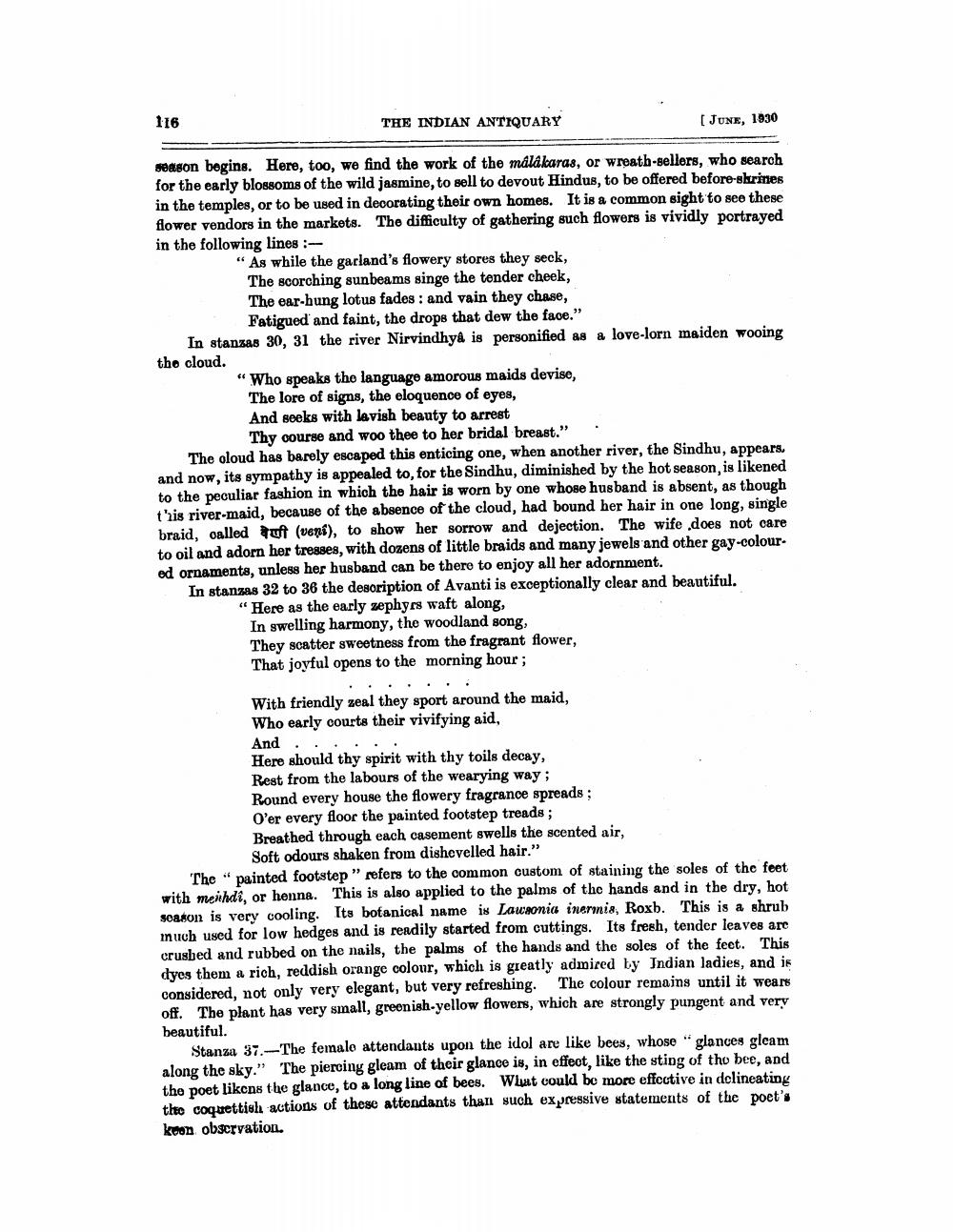________________
116
THE INDIAN ANTIQUARY
(JUNE, 1930
Season begins. Here, too, we find the work of the malakaras, or wreath-sellers, who search for the early blossoms of the wild jasmine, to sell to devout Hindus, to be offered before-skrines in the temples, or to be used in decorating their own homes. It is a common sight to see these flower vendors in the markets. The difficulty of gathering such flowers is vividly portrayed in the following lines :
“As while the garland's flowery stores they seck,
The scorching sunbeams singe the tender cheek, The ear-hung lotus fades : and vain they chase,
Fatigued and faint, the drops that dew the face." In stanzas 30, 31 the river Nirvindhya is personified as a love-lorn maiden wooing the cloud.
"Who speaks the language amorous maids devise,
The lore of signs, the eloquence of eyes, And seeks with lavish beauty to arrest
Thy course and woo thee to her bridal breast." The oloud has barely escaped this enticing one, when another river, the Sindhu, appears. and now, its sympathy is appealed to, for the Sindhu, diminished by the hot season is likened to the peculiar fashion in which the hair is worn by one whose husband is absent, as though this river-maid, because of the absence of the cloud, had bound her hair in one long, single braid, called fuff (veni), to show her sorrow and dejection. The wife does not care to oil and adorn her tresses, with dozens of little braids and many jewels and other gay-colour. ed ornaments, unless her husband can be there to enjoy all her adornment. In stanzas 32 to 36 the desoription of Avanti is exceptionally clear and beautiful.
"Here as the early zephyrs waft along,
In swelling harmony, the woodland song, They scatter sweetness from the fragrant flower, That joyful opens to the morning hour;
With friendly zeal they sport around the maid, Who early courts their vivifying aid, And ...... Here should thy spirit with thy toils decay, Rest from the labours of the wearying way; Round every house the flowery fragrance spreads ; O'er every floor the painted footstep treads ; Breathed through each casement swells the scented air,
Soft odours shaken from dishevelled hair." The painted footstep” refers to the common custom of staining the soles of the feet with mehdi, or henna. This is also applied to the palms of the hands and in the dry, hot season is very cooling. Its botanical name is Lawsonia inermis, Roxb. This is a shrub much used for low hedges and is readily started from cuttings. Its fresh, tender leaves are crushed and rubbed on the nails, the palms of the hands and the soles of the feet. This dyes them a rich, reddish orange colour, which is greatly admired by Indian ladies, and is considered, not only very elegant, but very refreshing. The colour remains until it wears off. The plant has very small, greenish.yellow flowers, which are strongly pungent and very beautiful.
Stanza 37. The femalo attendants upon the idol are like bees, whose "glances gleam along the sky." The piercing gleam of their glance is, in effeot, like the sting of the bee, and the poet likens the glance, to a long line of bees. What could be more effective in delineating tito coquettish actions of these attendants than such expressive statements of the poet's kcon observation




